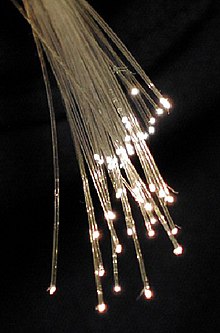Fluoride glass

Fluoride glass is a class of non-oxide optical glasses composed of fluorides of various metals. Due to their low viscosity, it is very difficult to completely avoid the occurrence of any crystallization while processing it through the glass transition (or drawing the fiber from the melt).
Thus, although heavy metal fluoride glasses (HMFG) exhibit very low optical attenuation, they are not only difficult to manufacture, but are quite fragile, and have poor resistance to moisture and other environmental attacks.
Fluoride glasses' best attribute is that they lack the absorption band associated with the hydroxyl (OH) group (3200–3600 cm−1) which is present in nearly all oxide-based glasses.[1]
Properties
HMFGs were initially slated for optical fiber applications, because the intrinsic losses of a mid-IR fiber could, in principle, be lower than those of silica fibers, which are only transparent to wavelengths shorter than ~2 μm.
Such low losses were never realized in practice, and the fragility and high cost of fluoride fibers made them less than ideal as primary candidates. Later, the utility of fluoride fibers for various other applications was discovered.
These applications include mid-IR spectroscopy, fiber-optic sensors, thermometry, and imaging. Also, fluoride fibers can be used for guided lightwave transmission in media such as YAG (Yttrium aluminium garnet) lasers at 2.9 μm, as required for medical applications (e.g. ophthalmology and dentistry).[2][3]
An example of a heavy metal fluoride glass is the ZBLAN glass group, composed of zirconium, barium, lanthanum, aluminum, and sodium fluorides. These materials' main technological application is as optical waveguides in planar and fibre form. They are advantageous especially in mid infrared (2000-5000 nm) range.[4]
Production
Some fluoride glasses are difficult to produce on Earth due to their rapid crystallization. The crystallization is slower in microgravity conditions due to reduced convection effects.[5]
Fluoride glass may also mean an oxide optical glass doped with zirconium tetrafluoride.[6]
A mix of fluoride glass and phosphate glass is fluorophosphate glass.
Fluoride glasses based on zirconium fluoride are a class of fluorozirconate glasses. ZBLAN glasses belong to this group as well.
Fluoride glasses based on aluminium fluoride are a class of fluoroaluminate glasses.
Doping praseodymium in fluoride glass allows it to be used as a single mode fiber optical amplifier (PDFA see also EDFA).
Optical elements made of calcium fluoride, namely of fluorite crystals, are used in some telephoto lenses, to correct chromatic aberration. They are however being replaced with various low-dispersion glasses, which have higher refractive indexes, better dimensional stability, and lower fragility.
References
- ^ heavy-metal fluoride glass (glass), Britannica Online Encyclopedia
- ^ Tran, D., et al., Heavy metal fluoride glasses and fibers: A review, J. Lightwave Technology, Vol. 2, p. 566 (1984)
- ^ Nee, S.F., et al., Optical and surface properties of oxyfluoride glasses, Proc. SPIE, Vol. 4102, p. 122 (2000); Characterization of optical constants for transparent materials, in Properties and Characteristics of Optical Glass, Ed. A.J. Marker III, Proc. SPIE, Vol. 979, p. 62 (1988)
- ^ "Archived copy". Archived from the original on 2012-08-21. Retrieved 2010-01-21.
{{cite web}}: CS1 maint: archived copy as title (link) - ^ Glass from Space, NASA-supported researchers have discovered that glass formed in space has remarkable properties. April 14, 2003, Author: Karen Miller, Dr. Tony Phillips
- ^ Definition of fluoride glass, iDigitalPhoto Dictionary
